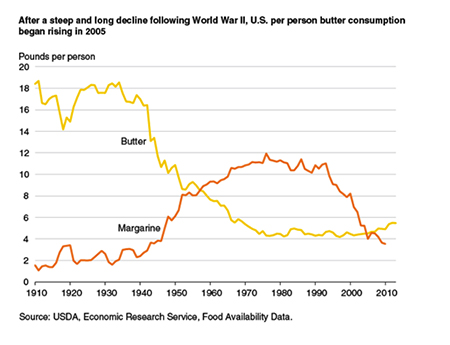In September, the FDA began the process of promulgating new rules to determine what foods could carry the label “healthy.” In addition to updating standards set 30 years ago, when margarine was healthier than butter, the goal was to reduce “the burden of chronic disease and advance health equity.” There’s been quick pushback by food manufacturers, but that’s not surprising. Before considering the meaning of healthy, let’s consider the  FDA’s claim that food labels can provide information.
FDA’s claim that food labels can provide information.
The key word here is cannote does. A recent marketing study noted that labels promoting products, like using the term healthy, increased consumption, especially when placed on the front of packages. But according to the FDA’s proposed rule
“Some consumers use nutrient content claims such as ‘healthy’ to inform their food purchases. We estimate that a small number (0 to 0.4 percent of people who try to follow current dietary guidelines) of these consumers would use the ‘healthy’ implied nutrient content claim to make meaningful, long-lasting food purchasing decisions.”
According to the regulators, the impact barely moves the needle in reducing chronic disease or promoting health equity.
To qualify as a healthy food, it must contain
- “meaningful amount of food from at least one of the main food groups or subgroups — fruits, vegetables, dairy, whole grains, etc.”
- “… limited amounts of added sugars — which were not previously included in the standards — and sodium: generally speaking the FDA suggested no more than 230 milligrams of sodium, and 2.5 grams of added sugars.”
- “… the new rules will assess the type of fat, with a focus on limiting saturated fat. Because of this change, healthy, high-fat food —like avocados, nuts, seeds, and fish — that previously didn’t qualify as healthy, now will.”
Among the foods which will now be considered healthy are game meats, nuts, and seeds. Since few of us are hunters, let us move on from game meats and consider nuts and seeds. Nuts and seeds are not currently “healthy” because of their high-fat content, although most are “good” unsaturated fats. This mis-measurement of the meaning of healthy came to light in 2015 when the FDA notified Kind, the snack manufacturer, that its product was not healthy due to the high-fat content in its nut-filled snack bars. Kind and others submitted a formal petition for the FDA “to update its regulations around the term healthy when used as a nutrient content claim in food labeling” to reflect current science. The FDA reversed its course in 2016.
According to Kind and now the FDA, nuts, and seeds are healthy foods. Of course, that doesn’t pertain to the roughly 1% of US consumers with allergies to nuts and seeds. For those individuals, no matter what the FDA or Kind say or label, nuts are unhealthy; they may even be lethal. And that, in short, encapsulates the real problem: there is no overall consensus about your healthy diet. There are general agreements for what is healthy for a population, but for precise dietary advice, labels can be misleading.
Is there a difference between nutritious and healthy?
Nutritious food provides the building blocks our metabolisms need to grow, maintain and repair our bodies. Healthy foods support those nutritional needs without causing harm. But as in the nut example, nutritious and healthy are not equivalent. That makes a top-down regulatory approach a fool’s errand; Food science is not wise enough to fully identify the healthy from the nutritious because it deals with populations, not individuals. But because regulators must regulate, and advocacy groups concerned with our “health” or the market niche of their product must advocate, we are treated to a new cycle sideshow of conflicting beliefs presented as truths. We should be more humble in the face of our ignorance.
As to advancing health equity, labels are not access or education. Health equity concerning our diet comes from making “healthy” foods both desirable and less expensive; what’s considered a “healthy” diet is often more costly than a simply nutritious one.
“Give a Man a Fish, and You Feed Him for a Day.
Teach a Man To Fish, and You Feed Him for a Lifetime.”
We have stopped teaching the practical art of choosing and making our meals. We have failed at least two generations because these life skills could either be learned at home or were unimportant compared to more pressing marketable skills. The same holds for the life skill of being active, which is only taught in the context of a game like soccer.
Using regulations to create labels to promote better dietary choices is like giving a man a fish; it is transient at best, and breeds continued dependency upon others to constantly guide you. The real solution lies in teaching our children to “fish” for those foods that are healthy for them.
Sources: The FDA issues new guidelines on what foods can be labeled ‘healthy’ Washington Post
Food fight: The FDA is redefining ‘healthy’ and the food industry is pushing back the Washington Post
